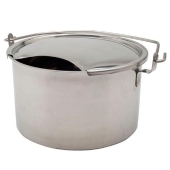









List of Bryant RedHawk's Epic Soil Series Threads We love visitors, that's why we live in a secluded cabin deep in the woods. "Buzzard's Roost (Asnikiye Heca) Farm." Promoting permaculture to save our planet.




















List of Bryant RedHawk's Epic Soil Series Threads We love visitors, that's why we live in a secluded cabin deep in the woods. "Buzzard's Roost (Asnikiye Heca) Farm." Promoting permaculture to save our planet.




Bryant RedHawk wrote:I use 1070 mild steel for mine. I heat it in my forge and then hammer it to fit. I have a standing ring that the cask staves are set into and it has an adjustable clamp to pull the staves tight to each other at the middle, then I can use rope or strap clamps to pull the ends together for hooping.
The problem with anyone making bands for sale would be making them so they would fit tight and so hold the staves of an unknown barrel together.
At the big Cooperages they have turned this into one of the specialty jobs.
Are you just wanting to try coopering or are you trying to make this a hobby? There is a lot to learn to be a cooper and several specialty tools are needed too.
















List of Bryant RedHawk's Epic Soil Series Threads We love visitors, that's why we live in a secluded cabin deep in the woods. "Buzzard's Roost (Asnikiye Heca) Farm." Promoting permaculture to save our planet.




Bryant RedHawk wrote:Wood bands look nice, are pretty easy to make too.
coopering is a good book to have












 1
1




List of Bryant RedHawk's Epic Soil Series Threads We love visitors, that's why we live in a secluded cabin deep in the woods. "Buzzard's Roost (Asnikiye Heca) Farm." Promoting permaculture to save our planet.




















List of Bryant RedHawk's Epic Soil Series Threads We love visitors, that's why we live in a secluded cabin deep in the woods. "Buzzard's Roost (Asnikiye Heca) Farm." Promoting permaculture to save our planet.
 1
1








 3
3




Brian-- The heraldic "arms" of the European cooper's guilds usually included the three main tools of the trade: the short-handled broadax to hew staves, the croze to cut the groove for the head, and the set-up hoops. That is, a graduated set of hoops in all sizes, stout enough to pound on for years, is a main tool. When I worked in the cooper shop at the Ozark Folk Center, there was already a partial set there, made by the blacksmiths of mild steel bar stock, about 1/2 inch wide by 1/8 or 3/16 thick, arc welded solid and ground smooth. These were then rounded and splayed (tapered) by hammering down on a mandrel (a heavy steel cone) to stretch the lower edge. The thickness gave good purchase for the wooden hoop drivers we used. (My teacher was from Appalachia, and his were of laurel-- I made mine of persimmon, with a few of dogwood.) But the splay was never sufficient on many of them, and I had to hammer them out and re-round them.Brian Sayers wrote:Where can a person buy holding hoops for making wooden buckets that you use while making the bucket before replacing them with
The permanent hoops that you make

| I agree. Here's the link: http://stoves2.com |






